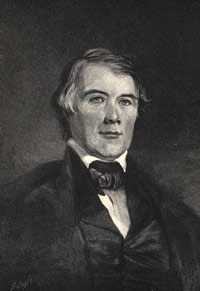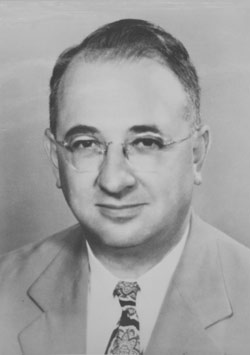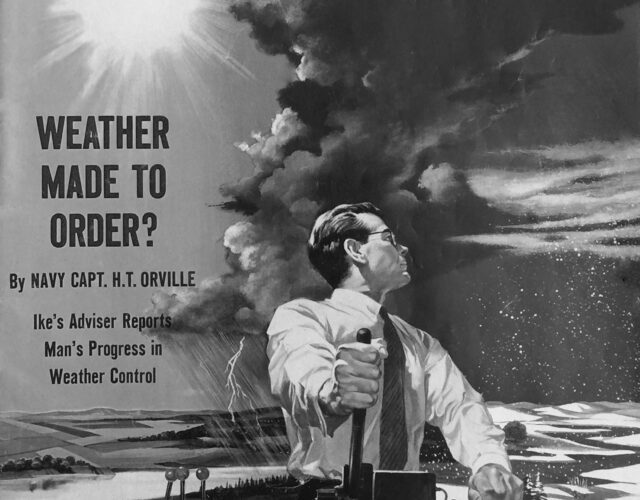In the 1830s meteorologist James P. Espy developed the theory that convection was the primary cause of rain. As heated updrafts rose into the sky, they cooled and their moisture condensed, resulting in cloud formation and precipitation. This innovative theory led to Espy’s employment by the U.S. Army as the nation’s first meteorologist, and posed a question that remains with us today: can humans mimic this natural process? He embellished his theory with the notion that under favorable conditions lighting huge fires along the Appalachian Mountains would provide the heat, smoke, and particulate matter needed to trigger storms and enhance the nation’s rainfall. Espy pitched his idea to Congress, likening his plan to the creation of artificial volcanoes. He claimed that if fires were set each week (he preferred Sunday evenings), the regular rains would eliminate droughts, heat waves, and cold snaps; keep the rivers navigable; and render the air healthy by clearing it regularly of noxious vapors.
Today some climate engineers claim they are the first generation to propose the deliberate manipulation of the planetary environment. History says otherwise. Over the past two centuries dreams of weather and climate control have produced a series of ill-considered and ill-fated interventions aimed at what at the time seemed the most pressing issues of the day: from health and farming in the 1830s, western drought in the 1890s, and fog and aviation in the 1920s, to cold-war attempts to use weather as a weapon, and on to current heroic responses to global warming.

Although Espy was justifiably celebrated for his convective theory, his reputation was tarnished by the ridicule his rainmaking proposal received. Nathaniel Hawthorne thought Espy belonged in the “Hall of Fantasy”—a marketplace of wild ideas perfectly suited to the fantasies of rain kings and climate engineers: “Professor Espy was here,” reminiscent of Aeolus, the god of the winds, “with a tremendous storm in a gum-elastic bag.” A popular writer, Eliza Leslie, pointed out that Espy’s manufactured weather could never satisfy everyone’s weather desires.
Fifty years later a new generation of weather alchemists set out to confront drought in the American West. Robert St. George Dyrenforth, a flamboyant patent attorney from Washington, D.C., was certain that explosions in midair could cause rain. Dyrenforth, with a grant from the U.S. Department of Agriculture, took a team of artillerists to Texas to attack the atmosphere on multiple fronts with dynamite and blasting powder, mortar shells, smoke bombs, electrified kites, exploding oxy-hydrogen balloons, and even fireworks.
During a dry spell in the late summer of 1891, but conveniently at the (commonly known) onset of the annual rainy season in the Texas Panhandle, Dyrenforth and his ersatz army engaged in “a perfect imitation of battle”—a war on drought. Without taking any careful or systematic measurements—they did not have a rain gauge and their meteorologist left early—the team took credit for every shower of rain that fell, near or far, before or after the barrages. Local citizens were entertained and duly impressed, but the press had a field day. F. W. Clarke’s humorous poem “Tale of the Rain Machine,” published in Life in 1891, was inspired by the Dyrenforth experiments. In the poem the hapless farmer Jeremy Jonathan Joseph Jones seeks to break a drought using “cannon, and mortars, and lots of shells, and dynamite by the ton, with a gas balloon and a chime of bells, and various other mystic spells to overcloud the sun.” His third shot into a cloudless sky “brought a heavydew”; his fourth, tornadoes, “thunder, rain, and hail.” Jeremy drowned in the ensuing flood, and his farm became a lake. All efforts to stop the deluge were in vain, “Until the Bureau at Washington stirred, and stopped the storm with a single word, by just predicting—Rain!”
Fog dissipation for aviation safety took center stage in the second quarter of the 20th century. Experiments on electrified sand dispersed from aircraft, chemical sprays on airfields, and the FIDO (Fog Investigation and Dispersal Operation) fog burners of World War II all attracted high-level military support. “Fliers Bring Rain with Electric Sand,” a New York Times headline announced in 1923. The story itself, however, was underwhelming. Between 1921 and 1923 field trials conducted in Dayton, Ohio, at McCook Field seemed to show that electrified sand could dissipate clouds and might someday both dispel fog and generate artificial rain. The demonstrations were the brainchild of the controversial Cornell University chemist Wilder Bancroft and his entrepreneurial sidekick L. Francis Warren, a self-styled and self-taught independent inventor and dreamer who frequently misstated his credentials as “Dr. Warren of Harvard University.”
Between 1921 and 1923 field trials seemed to show that electrified sand could dissipate clouds and might someday both dispel fog and generate artificial rain.
Although the hope of clearing fogs, making rain, and driving mists from cities, harbors, and flying fields was great, the hype was even greater. Electrical precipitators had long been used for removing smoke, dust, and fumes from industrial gases, but these operated in enclosed spaces, not in the free atmosphere. Theory seemed to indicate that sprinkling electrically charged sand above fog or clouds would lead to the coalescence of the cloud droplets. In practice it was fraught with problems and met with only limited success. The May 1923 issue of Popular Science Monthly described the Warren-Bancroft demonstrations as follows: “Think of it! Rain when you want it. Sunshine when you want it. Los Angeles weather in Pittsburgh and April showers for the arid deserts of the West. Man in control of the heavens—to turn them on or shut them off as he wishes.” None of this ever happened. Bancroft nearly went broke supporting Warren’s commercial brainstorms. By 1925 the military, which provided aircraft facilities, quietly withdrew its support for the project.
Increasing Power, Growing Concerns
A decade later Henry G. Houghton of the Massachusetts Institute of Technology tried spraying solutions of calcium chloride and other chemical drying agents from an array of pipes installed over an airfield. With fog continually rolling in from the ocean, Houghton realized the impracticability of this approach, but his work provided support for later operational aircraft-deicing treatments. During World War II the British developed FIDO—a brute force approach, not unrelated to Espy’s giant fires, that burned thousands of gallons of gasoline to drive off the fog and create a lighted, heated runway that gave Allied fliers the edge over their German counterparts. A crash program initiated during Britain’s darkest hours, FIDO was credited with saving thousands of airmen’s lives but was much too expensive for commercial use. The main technique for dealing with fog, developed after the war, was not weather or cloud modification but the widespread use of instrumented landing techniques.
In 1946 Nobel laureate Irving Langmuir believed he and his team at the General Electric Corporation had discovered means of controlling the weather with such cloud-seeding agents as dry ice and silver iodide. A year later, in conjunction with the U.S. military, they sought to deflect a hurricane from its path. After seeding (but not because of seeding) the hurricane veered onshore, owing to what were later determined to be natural steering currents, and devastated Savannah, Georgia. The planned press conference was canceled, but Langmuir continued to claim he could control hurricanes and influence the nation’s weather. He even proposed seeding the entire Pacific basin in a mega-scale experiment intended to generate climate-scale effects.
An image of a technocrat pulling the levers of weather control appeared on the cover of Collier’s in 1954. The United States was in a weather-control race with the U.S.S.R., and a Strategic Air Command general had just announced in the press that the nation that controlled the weather would control the world. The accompanying article, by President Dwight D. Eisenhower’s weather adviser Harold Orville, included ways of conducting weather warfare. A year later Fortune published a prominent article by John von Neumann: “Can We Survive Technology?” referred to climate control through managing solar radiation or changing the earth’s heat budget as a thoroughly “abnormal” industry that could have “rather fantastic effects” on a scale difficult to imagine. Von Neumann, a noted mathematician and pioneer in computerized weather forecasts and climate models, pointed out that altering the surface reflectivity of specific regions or redirecting air masses in an attempt to trigger a new ice age were not necessarily rational undertakings. Tinkering with the earth’s heat budget or the atmosphere’s general circulation, he claimed, “will merge each nation’s affairs with those of every other more thoroughly than the threat of a nuclear or any other war may already have done.” In his opinion climate control could lend itself to unprecedented destruction and to forms of warfare as yet unimagined. It could alter the entire globe and shatter the existing political order. He made the Janus-faced nature of weather and climate control clear. The central question was not “What can we do?” but “What should we do?” This was the “maturing crisis of technology” for von Neumann, in which technological realities and possibilities—from nuclear warfare to climate engineering—might undermine the very existence of nation states and the treaties and ties that bind them.

Harry Wexler.
Taking this up several notches—to the stratosphere and above—was Harry Wexler, head of research at the U.S. Weather Bureau. In 1962 Wexler warned that a hostile power could detonate a chlorine or bromine bomb that would rip a giant hole in the earth’s ozone layer. He had in effect identified catalytic ozone-depleting reactions that would later result in Nobel prizes in chemistry. Wexler also warned that space spectaculars might go awry: “Even in this day of global experiments, such as the world-wide Argus electron seeding of the earth’s magnetic field at 300 miles height, man and machinery orbiting the earth at 100 miles 17 times in one day, and 100 megaton bombs—are we any closer to some idea of the approaches which could lead to an eventual ‘solution’ [to the problem of climate control]?” He noted “a growing anxiety” in the public, pronouncing, “Man, in applying his growing energies and facilities against the power of the winds and storms, may do so with more enthusiasm than knowledge and so cause more harm than good.” Ironically, Operation Argus, a 1958 military experiment that disrupted the magnetosphere and generated an artificial radiation belt (via high-altitude nuclear-weapons detonations), was planned and conducted the very same year James van Allen announced his discovery of the earth’s natural radiation belts.
All this activity was supported at the top levels of government by then-Senator Lyndon Johnson’s proclamation that the very future of the United States depended on its first seizing ownership of space and controlling it for military purposes. In the cold-war era the military sought to control clouds and storms as weapons. As part of the “weather race,” secret cloud seeding occurred during the Vietnam War. This seeding resulted in the 1978 United Nations Convention on the Prohibition of Military or any other Hostile Use of Environmental Modification Techniques (ENMOD), a landmark treaty that may have to be revisited soon to avoid or at least try to mitigate possible hostile use of climate control.
Saving the World?
Today proposals for space mirrors, ocean iron fertilization, and injections of reflective sulfates or engineered nanoparticles into the stratosphere for climate control are being pitched by modern rain kings and queens. In China farmers armed with artillery weapons form part of the world’s largest rainmaking (and rain-clearing) force. In 2009 and 2010 government officials from the United States and the United Kingdom convened panels to discuss geoengineering (also known as geohacking or geoscientific speculation) whose advocates propose to modify the earth’s climate deliberately on a planetary scale. In September 2009 the Royal Society of London published Geoengineering Climate, a report on the potential risks of proposals to “fix the sky,” including if, when, and how research and deployment should proceed and how it might be governed. Possible side effects of solar-radiation management via such techniques as stratospheric reflective sulfates include drought in the tropics and damage to the ozone layer. Furthermore, the report notes that “risk exists that some methods could be deployed by individual nation states, corporations or even one or more wealthy individuals without appropriate regulation or international agreement.” This report was followed by panels and testimony on geoengineering in the U.S. House of Representatives and the U.K. House of Commons, with many still advocating field research and even deployment despite the risks—and the beat goes on.
In my Congressional testimony in November 2009 I reviewed the checkered history of weather and climate control. I recommended that the first steps toward effective collaboration on geoengineering research and governance should not be technically oriented. Instead it should involve study of the historical, ethical, legal, political, and societal aspects of geoengineering. I made the claim that climate change is not quintessentially a technical issue; it is a sociocultural and technical hybrid, and our effective response to it must be historically and technically informed, interdisciplinary in nature, international in scope, and intergenerational in its inclusiveness.
Geoengineering is in fact untested and dangerous. We don’t understand it; we can’t test it on smaller than planetary scales; and we don’t have the political capital, wisdom, or will to govern it. Planetary tinkering is not “cheap,” as some economists claim, since the side effects are unknown. It poses a moral hazard by possibly reducing incentives to mitigate. It could be attempted unilaterally, or worse, proliferate among rogue states, and it could be militarized (learning from history, it likely would be militarized). Geoengineering could violate a number of existing treaties such as ENMOD, which, as von Neumann warned so long ago, would add to international stresses. Most poignantly, by turning the blue sky milky white or the blue oceans soupy green, by attenuating starlight, and by putting bureaucrats and technocrats in charge of a global thermostat, it will alter fundamental human relationships to nature.
Throughout history rainmakers and climate engineers have typically fallen into two categories: commercial charlatans using technical language and proprietary techniques to cash in on a gullible public and sincere but deluded scientific practitioners exhibiting a modicum of chemical and physical knowledge, a bare minimum of atmospheric insight, and an abundance of hubris. We should base our decision making not on what we think we can do now and in the near future. Rather our knowledge is shaped by what we have and have not done in the past. Such are the grounds for making informed decisions and avoiding the pitfalls of rushing forward claiming we know how to fix the sky.




